Understanding VVS Diamonds and Their Classification
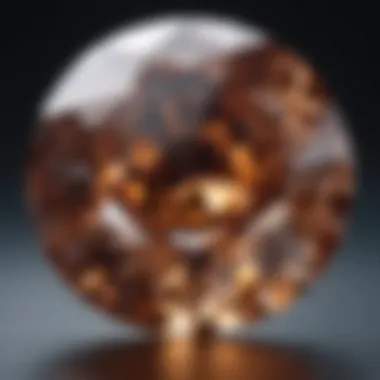
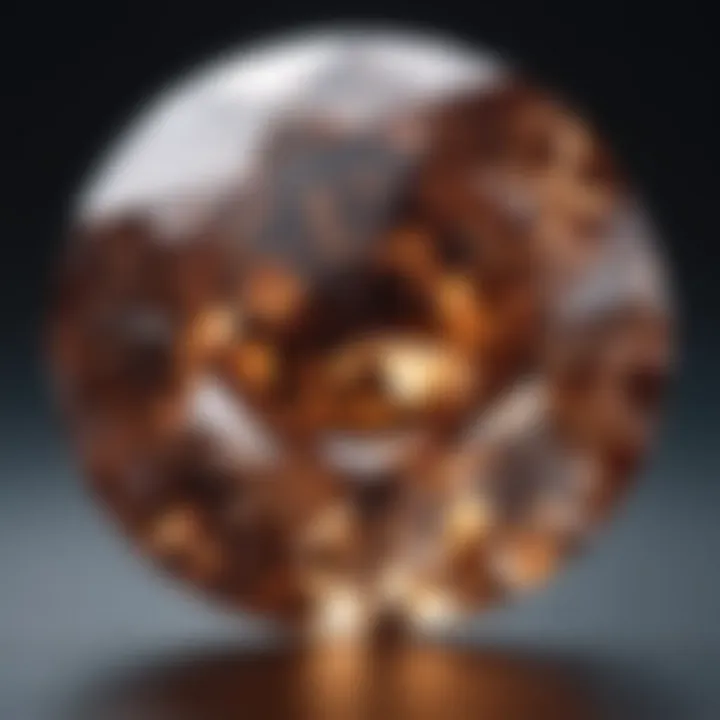
Intro
Diamonds have fascinated humanity for centuries. They are often considered symbols of wealth, power, and romance. But within the diverse world of diamonds lies a specific category that stands out: VVS diamonds. VVS stands for "Very, Very Slightly included," a grade that highlights a level of clarity that many collectors and enthusiasts highly regard. In this guide, we will take a closer look at VVS diamonds, exploring what sets them apart from other types, the criteria for their classification, and their significance in the gemstone market.
Gemstone Overview
Definition and characteristics
VVS diamonds are characterized by nearly perfect clarity. When assessing a diamond, gemologists use various grading scales, and VVS is among the highest ratings available. This grade indicates that the stone contains very small inclusions that are difficult to detect even under magnification. To the naked eye, these diamonds appear flawless, allowing them to shine with exceptional brilliance and fire. Their superior clarity contributes to their desirability, often leading to higher retail prices compared to less clear counterparts.
Classification of gemstones
Gemstones, particularly diamonds, are classified based on a variety of factors such as clarity, color, cut, and carat weight. This system is known as the 4Cs. Here’s a brief breakdown:
- Clarity: Refers to the presence of internal or external flaws. VVS diamonds score highly in this category.
- Color: Ranges from colorless to tinted. The rarest diamonds are those that are completely colorless.
- Cut: Shapes and styles can affect the diamond's overall appearance and brilliance.
- Carat Weight: Refers to the size of the diamond, impacting its value and desirability.
These classifications help jewelers and buyers understand the quality and worth of gemstones. Thus, recognizing the type of diamond one is dealing with becomes very important.
Properties of Gemstones
Physical properties
Diamonds exhibit unique physical properties, making them one of the toughest materials on Earth. Their hardness is rated a 10 on the Mohs scale. Some other notable properties include:
- Brilliance: The way light interacts with the diamond, due largely to its cut.
- Fire: The dispersion of light into various colors.
- Scintillation: The sparkle that comes from internal light reflection.
In the case of VVS diamonds, these physical properties are enhanced due to their clarity, making them a prime choice for both collectors and engagement rings.
Chemical properties
From a chemical standpoint, diamonds are composed of carbon atoms arranged in a crystal structure, which allows for their famed hardness and brilliance. When it comes to VVS diamonds, the lack of noticeable inclusions also contributes to their stability. The purity of these gems can sometimes lead to higher value as collectors often seek stones with fewer impurities.
"A diamond is like a story—a unique narrative, shaped by pressure and time, resulting in something that can be both beautiful and enduring."
Foreword to Diamond Classification
The realm of diamond classification stands as a foundational pillar in understanding the precious gemstone world. It is not merely a systematic approach but rather an intricate art that merges science and perception. When one hears the term ‘diamond’, they often conjure images of glistening stones and luxurious adornments. However, the true essence of diamonds is uncovered when we delve into their grading and classification. It allows consumers and collectors alike to appreciate the nuances that lie beneath a diamond’s exterior, elevating their buying and collecting experiences.
The Importance of Diamond Grading
Grading diamonds serves as a bridge that connects the aesthetic allure of these gemstones with their market value and desirability. Every diamond is assessed on a series of specific criteria, which cumulatively determine its classification and ultimately, its price. The diamond grading system is vital for several reasons:
- Consistency in Valuation: Diamond grading provides a standard that ensures diamonds of similar qualities are evaluated similarly across the board. This consistency is essential for buyers and sellers, creating a more transparent marketplace.
- CEO Revenue Stability: Businesses can effectively manage their inventory and pricing strategies depending on the grading standards. A jeweler familiar with diamond grading can advise clients better, encouraging informed purchases that lead to customer satisfaction.
- Enhancing Collector's Knowledge: For enthusiasts, understanding grading offers insights that increase appreciation for the artistry and complex nature of diamond creation and classification. Knowledge about grades enables collectors to make informed choices, especially when focusing on collectible aspects.
Overview of the 4Cs
In the world of diamonds, the 4Cs—Carat, Cut, Color, and Clarity—represent the primary criteria for assessing a diamond's quality and value:
- Carat: This refers to the weight of the diamond. Larger carat weights often indicate higher value, yet this is not absolute, as the other Cs also play crucial roles.
- Cut: The cut examines how well a diamond's facets interact with light. A well-cut diamond will sparkle and shine, while a poor cut may appear dull, irrespective of its size or clarity.
- Color: Diamonds come in a range of colors from clear to various hues, with color grades extending beyond white diamonds into the fancy color category. A colorless diamond typically holds more value.
- Clarity: Clarity refers to the presence of internal or external blemishes. This is where VVS diamonds fall, boasting very slight inclusions that are nearly impossible to view without the aid of a microscope.
The interplay of these characteristics not only defines the diamond itself but also its positioning in the marketplace. For a diamond enthusiast or a jewelry designer, comprehending the 4Cs serves as a vital tool in recognizing value and beauty in diamonds.
"In the world of diamonds, understanding the intricacies of grading transforms a mere stone into a piece of art, elevating its importance beyond monetary value."
As we dive deeper into understanding VVS diamonds, the foundations laid by these grading principles become absolutely vital, guiding collectors and potential buyers to make choices that resonate with both personal taste and financial acumen.
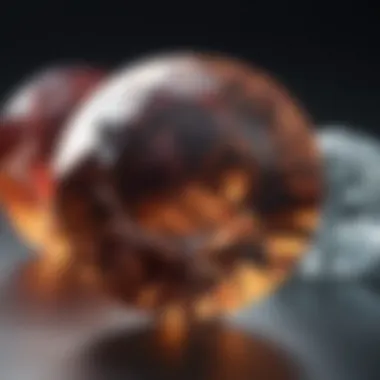

Defining VVS Diamonds
In the realm of gemstones, VVS diamonds hold a special spot due to their remarkable clarity and exquisite nature. Defining VVS diamonds is crucial, not just for those in the jewelry business, but also for enthusiastic collectors who wish to make informed decisions.
When discussing VVS diamonds, we delve into nuances that can profoundly affect their visual appeal and value. The purity of these diamonds plays a significant role in determining their brilliance, making their definition a linchpin in understanding broader diamond classifications.
What Does VVS Stand For?
VVS is an abbreviation that stands for Very-Very Slightly Included. This classification reflects diamonds that have minuscule inclusions, which are nearly invisible to the untrained eye, often requiring magnification to detect. The scale of clarity runs from Flawless to Included, with VVS diamonds nestled comfortably near the top.
The designation itself informs potential buyers about the quality of the stone, ensuring confidence in its beauty and investment value. Many people find that even under scrutiny, the inclusions in a VVS diamond can be difficult to discern, enhancing its allure.
The Quality Crystal Structure
The quality of a diamond's crystal structure is instrumental in defining its clarity, including VVS diamonds. Diamonds are formed under immense pressure and heat like no other substance on Earth. This unique formation leads to a crystalline structure that is not just beautiful, but also gives it strength and brilliance.
Learning about this structure can provide you with deeper insight into why VVS diamonds are rated as such. VVS diamonds typically exhibit a solid, homogeneous structure that contributes to their light performance, making them truly radiant. This quality is paramount as it directly impacts a diamond's fire and scintillation.
"The allure of a diamond lies in its ability to refract and reflect light, revealing a dance of brilliance only found within flawless crystal structures."
Moreover, a diamond's inherent quality can be affected by the size and positioning of inclusions. VVS diamonds often possess very tiny imperfections that might, in some light, appear like specks of dust, but they still retain their stunning clarity and elegance.
Types of VVS Diamonds
When diving into the world of VVS diamonds, it becomes essential to clarify not just what these stones are but also the nuances that differentiate them. Understanding the distinct classifications under VVS—specifically VVS1 and VVS2—provides insight into their value and quality. This section will dissect these aspects, giving enthusiasts and collectors deeper knowledge.
VVS1 vs VVS2
The distinction between VVS1 and VVS2 lies primarily in the visibility and placement of inclusions, or blemishes, within the diamond. VVS1 diamonds carry fewer inclusions, and those that do exist are typically almost impossible to see under 10x magnification. In contrast, VVS2 diamonds may have slightly more visible inclusions, but again, they remain hard to detect with the naked eye.
Consider the following:
- Price Variability: VVS1 diamonds usually command a higher price due to their superior clarity, which can be a major factor for collectors aiming for perfection.
- Market Trends: Investing in VVS1 stones is often viewed as safer since they are rarer. The intrinsic quality of VVS1 might lead to stronger resale value over time.
Cut and Shape Variations
The cut of a diamond can dramatically influence how it captures and reflects light. While VVS diamonds boast clarity, their cut and shape can either amplify their beauty or detract from it. Here’s a closer look at various cuts popularly seen in VVS diamonds:
- Round Brilliant Cut: Perhaps the most famous cut, optimized for brilliance and fire. VVS diamonds in this form are highly desirable.
- Princess Cut: Known for its sharp edges and incredible sparkle, it’s a modern favorite.
- Emerald Cut: This cut emphasizes clarity, which means VVS diamonds shine in this format, showcasing their lack of inclusions.
While the cut enhances the visual appeal, shape can be subjective; some folks prefer classic shapes like round, while others might lean towards fancy shapes such as marquise or pear. If you’re in the market, considering how the cut affects the diamond's appearance is crucial.
Color Grading in VVS Diamonds
VVS diamonds are typically graded in the D to Z scale, with D being completely colorless. In this scale, the color grade impacts the perceived quality, making it another area where VVS diamonds shine. Most VVS diamonds fall within the G to J range, where:
- G-H: Considered near colorless. These diamonds look stunning when set in jewelry.
- I-J: Although they have slight warmth, color is often not visible when mounted.
An important note: While clarity is a strong point for VVS diamonds, their color grading can holistically affect value. The best practice when selecting a VVS diamond is to consider both clarity and color together when determining its desirability.
By examining the types of VVS diamonds, including the differences between VVS1 and VVS2, the significance of cut and shape, and the impact of color grading, collectors and enthusiasts can approach their selections and investments with confidence and clarity.
Comparison with Other Clarity Grades
When discussing VVS diamonds, a deeper understanding of their place in the larger scheme of diamond clarity grading is crucial. VVS, which stands for Very Very Slightly Included, signifies diamonds that possess exceptional clarity, showcasing only minor inclusions that are difficult to detect. This section implications of VVS diamonds in comparison to other clarity grades, such as Internally Flawless (IF) and Very Slightly Included (VS), provides prospective buyers and collectors with a clearer grasp of what to expect when investing in these gemstones.
Vs. Internally Flawless Diamonds
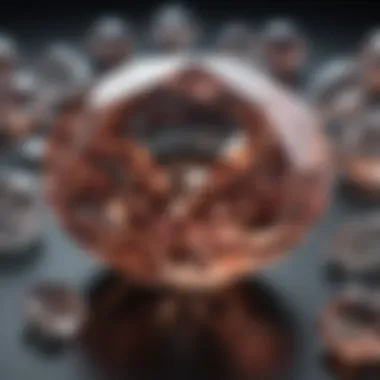
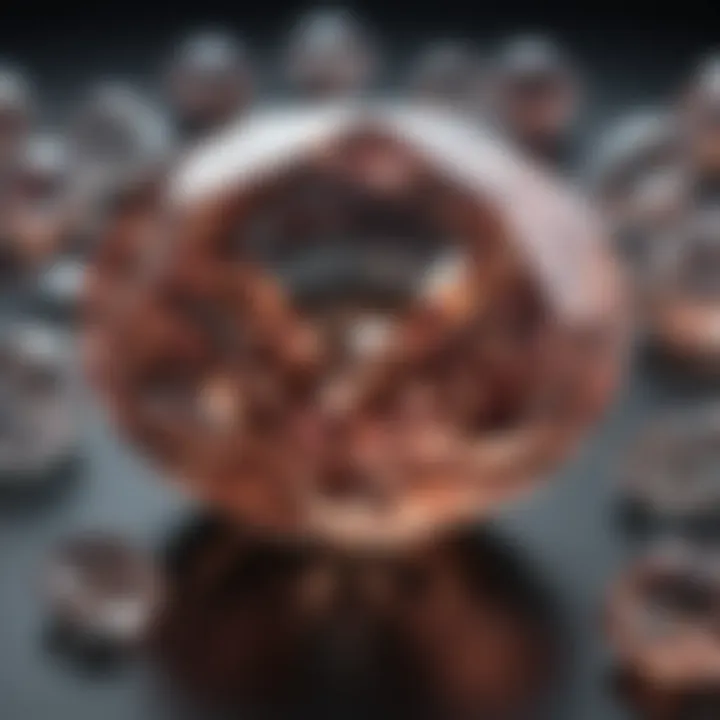
When we compare VVS diamonds to Internally Flawless diamonds, the distinctions are both subtle and significant. Internally Flawless diamonds, as the name suggests, exhibit no internal imperfections visible under 10x magnification, making them some of the most coveted stones in the market. In less technical terms, if VVS diamonds are elite athletes, Internally Flawless diamonds represent world champions.
Though both types boast remarkable clarity, the allure of Internally Flawless diamonds often drives up their market value. Collectors and investors tend to gravitate toward these flawless specimens, viewing them as the pinnacle of diamond quality. For gem enthusiasts, this can lead to a challenging landscape. The price difference might reflect not just the clarity but also the visual experience.
Some potential buyers could view the slight inclusions present in VVS diamonds as a way to acquire a stunning gem without splurging on a top-tier Internally Flawless piece. It's akin to settling for a luxury car from a renowned manufacturer that may have a minor imperfection, but still drives like a dream. For many, owning a VVS diamond allows an entry point into the world of high-quality gemstones while still maintaining a sense of prestige.
To put it succinctly, VVS diamonds are indeed radiant and offer outstanding value. However, if perfection is what a collector seeks, they may lean more towards the Internally Flawless options.
Vs. Very Slightly Included Diamonds
The comparison of VVS diamonds to Very Slightly Included diamonds highlights another layer of understanding in diamond clarity grading. Very Slightly Included diamonds, or VS, have minor inclusions that can be detected under 10x magnification, albeit with difficulty. In a way, you can think of VS diamonds as the entry-level luxury cars. They are well-built, reliable, and attractive, but perhaps lack that zesty spark of higher-end models.
VVS diamonds are generally more expensive than their VS counterparts due to their superior clarity. The key difference lies in how noticeable inclusions are. While VS diamonds may have inklings that can be observed, even by an average jewelry enthusiast, VVS diamonds usually require trained eyes to spot flaws.
For many buyers, this distinction is crucial. Those looking for an exquisite piece might prefer the VVS clarification, knowing that the very faint inclusions are practically invisible to the naked eye and typically enhance the stone's character rather than detract from it. On the flip side, VS diamonds can still offer beautiful aesthetics for those who appreciate a balance between value and quality without breaking the bank.
In the end, the decision comes down to personal preference and budget. Buyers should weigh the importance of clarity alongside their unique tastes and how they envision their purchase fitting into their life or collection.
"In the world of diamonds, clarity is not merely a grading system; it's an invitation to explore the nuance in each stone."
Understanding these distinctions not only enriches a buyer's experience but also enhances their appreciation of the craftsmanship involved in creating a diamond. Awareness of the differences between VVS, IF, and VS can lead to more informed purchasing decisions and ultimately a greater enjoyment of these remarkable gemstones.
The Market for VVS Diamonds
In recent years, the market for VVS diamonds has grown substantially. These gems, known for their superior clarity, have caught the fancy of collectors and investors alike. They represent a blend of rarity and quality that buyers often eye as a sound investment. Understanding the market dynamics surrounding VVS diamonds is crucial, not just for those looking to purchase them, but also for industry stakeholders who want to stay ahead in this evolving landscape.
Demand and Value Trends
The demand for VVS diamonds is not merely a reflection of personal preference; it's linked to broader trends in the luxury market. Many enthusiasts consider these diamonds as long-term investments, largely due to their impressive durability and aesthetic appeal.
Several factors drive the demand and value trends in the VVS category:
- Investment Appeal: VVS diamonds tend to hold their value better than lower-clarity stones, especially in challenging economic climates. Buyers view these gemstones as tangible assets that are less susceptible to inflation.
- Aesthetic Consideration: High clarity means that VVS diamonds grant maximum brilliance and sparkle. This visual aspect is a huge lure for those in the jewelry market.
- Cultural Significance: In many cultures, diamonds symbolize wealth and status, making VVS diamonds a choice for high-profile engagements and gifts.
- Market Accessibility: Online platforms and auctions have made it easier for a wider audience to access VVS diamonds, thus boosting demand.
The value of VVS diamonds tends to appreciate over time, which can be attributed to their limited availability. Unlike more common diamond grades, VVS diamonds are rarer, thus elevating their market price. As collectors become increasingly savvy, understanding these trends can enrich their purchasing decisions.
Ethical Sourcing Concerns
As the market for VVS diamonds expands, so does the scrutiny regarding their ethical sourcing. Many consumers are becoming increasingly aware of where their jewels come from, leading to rising concerns about conflicts and environmental impacts associated with mining.
Some pivotal points regarding ethical sourcing in this niche include:
- Conflict-Free Assurance: Buyers are now more inclined to seek diamonds that come with certifications, ensuring they are conflict-free and responsibly sourced.
- Sustainable Practices: Increased demand for environmentally friendly mining practices is shaping market offerings. Mines that promote sustainability and fair labor practices are receiving attention from ethical-minded consumers.
- Traceability: Customers often prefer diamonds whose origins can be traced back through various certifications, providing transparency about their sourcing.
- Market Responsiveness: Retailers are adapting to these concerns by providing more information about the origin of their diamonds, actively promoting those that meet ethical sourcing standards.
"A diamond's value is not just in its beauty but also in its journey to your hands. Ethical considerations play an essential role in today’s gemstone market."
Understanding these elements is critical for any prospective buyer or investor. With growing awareness among consumers, ethical sourcing might become a deciding factor that could influence market dynamics significantly in the coming years.
Investing in VVS Diamonds
Investing in VVS diamonds is not just a fleeting trend. It's an avenue for those who appreciate both beauty and value in the gemstone realm. Individuals diving into this market often see VVS diamonds as more than mere symbols of status; they represent a wise financial venture.
When we think about gemstones, VVS diamonds stand out not just for their exceptional clarity but also for their durability. These diamonds, being Very Very Slightly Included, provide a unique balance between aesthetic appeal and investment potential. Investors lean towards these gems for various compelling reasons.
First and foremost, VVS diamonds often hold their value well over time. Unlike other investments, their market isn’t heavily swayed by economic fluctuations but by genuine demand. As the world becomes more environmentally conscious, the push for ethically sourced diamonds grows. VVS diamonds, particularly those sourced responsibly, are becoming increasingly sought after, thus enhancing their investment value.
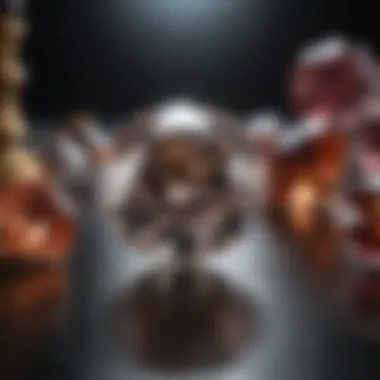
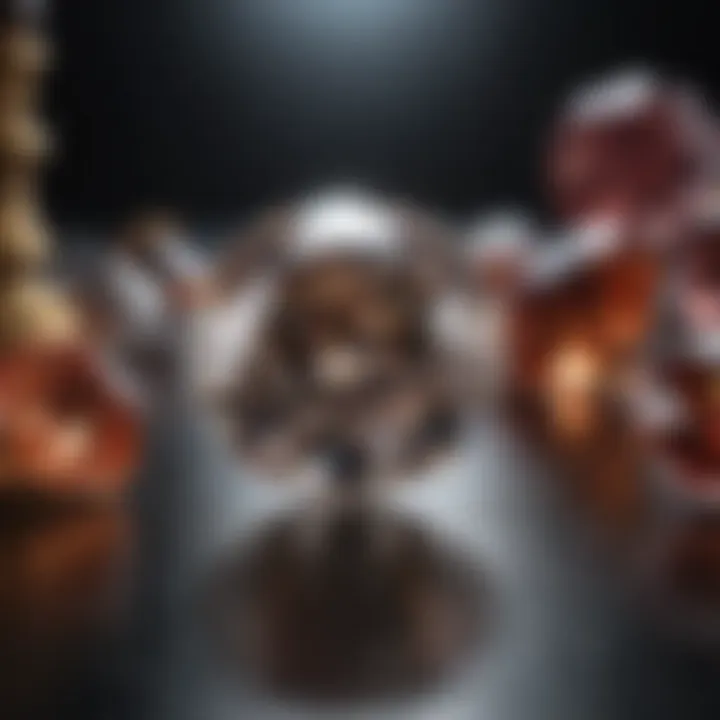
Here's a closer look at some key elements related to investing in VVS diamonds:
- Intrinsic Value: VVS diamonds are known to have fewer inclusions. This gives them a bright sparkle, making them highly desirable for collectors and investors alike.
- Market Stability: In a world of ups and downs, the market for VVS diamonds tends to be more stable, showing a consistent trend in value retention or increase.
- Demand: As noted, ethical sourcing plays a significant role. VVS diamonds that are conflict-free often see higher demand, thus solidifying their position in the market.
Investing in VVS diamonds can feel daunting, especially given the various factors influencing their value. Evaluating investment potential is crucial. It's important for buyers to familiarize themselves with market trends, clarity grades, and the nuances of diamond grading. Alas, understanding what makes a diamond valuable lets you make an informed choice.
Evaluating Investment Potential
When considering VVS diamonds as investment options, potential buyers should keenly evaluate several factors. The first aspect is understanding how the diamond's characteristics influence its market price. Here’s what to keep in mind:
- Clarity and Cut: VVS diamonds shine best when they are well-cut and possess top-notch clarity. The cut influences light performance, and as we know, light is what breathes life into a diamond.
- Market Trends: Keeping an eye on the economic landscape is vital. Trends can indicate which type of diamonds may become more valuable. For instance, during holidays or specific events, demand might spike.
- Rarity: Each VVS diamond is unique. Considering factors such as size, cut, and color can ensure you’re selecting a gem that not only fits your aesthetic but also holds potential for value appreciation.
- Certification: Ensure that the diamond comes with certification from reputable grading labs such as the GIA (Gemological Institute of America). A certified diamond has documented proof of its quality and authenticity, adding an extra layer of security to your investment.
By weighing these considerations, investors can increase their chances of making a savvy decision.
Long-Term vs Short-Term Value
The debate between long-term and short-term value in diamond investment is akin to the age-old question of a bird in the hand versus two in the bush. Short-term investors might look for immediate gains, often flipping diamonds in a bustling market for a quick return. However, this method can be fraught with uncertainty.
On the other hand, long-term investors typically see VVS diamonds as a store of wealth. The uniqueness and stability of VVS diamonds often lead to substantial gains over time. Here’s a breakdown:
- Short-Term Value: Investors focusing on quick profits may buy diamonds during market peaks or trendy seasons. However, this approach relies heavily on market timing, which can be quite challenging and carries risks.
- Long-Term Value: Holding onto VVS diamonds tends to yield better financial results. Over the years, as the diamond acquires more historical significance or as supply diminishes, its price usually appreciates, presenting a profitable return on investment.
Care and Maintenance of VVS Diamonds
Caring for VVS diamonds is truly essential. Though these gemstones are structurally sound and among the highest grades in clarity, they still require proper attention to maintain their brilliance and beauty. Understanding care procedures are key for both collectors and everyday wearers. Not only does regular maintenance keep the diamonds looking their best, but it also plays a significant role in preserving their value over time.
Cleaning Techniques
The allure of a VVS diamond is in its clarity and sparkle. Therefore, keeping it clean is paramount. Several methods can be used to ensure that your diamond dazzles without worry. Here are some effective cleaning techniques:
- Warm Soapy Water: Mix a few drops of mild dish soap in warm water. Use a soft bristle brush to gently scrub the diamond and the setting. Rinse it in clean water and pat dry with a lint-free cloth.
- Ultrasonic Cleaners: If you’re looking for a deeper clean, an ultrasonic cleaner can be helpful. These devices use sound waves to create tiny bubbles that gently lift dirt. Just be cautious with delicate settings and stones.
- Avoid Harsh Chemicals: When cleaning, steer clear of chlorinated cleaners or abrasive substances. These can damage the diamond or affect the setting.
A good rule of thumb is to clean your diamond every few weeks, especially if you wear it regularly. It’s like giving your gem a little spa day!
Storage Recommendations
Proper storage is just as important as cleaning. The way you store VVS diamonds can significantly affect their longevity and overall appearance. Here are a few tips for ideal storage:
- Soft Boxes or Pouches: Store your diamonds in soft pouches or lined boxes to prevent scratches. Avoid keeping multiple pieces of jewelry in a single compartment to minimize movement and friction.
- Away from Light and Heat: Diamonds can be sensitive to extreme heat and prolonged exposure to direct sunlight. A cool, dark place is ideal for storage.
- Regular Inspection: Check your diamonds periodically for any signs of wear or loose settings. This step is especially crucial if the piece is regularly worn, like an engagement ring.
Storing your diamonds properly helps ensure that they retain their brilliance and clarity, making them an eye-catching piece in any collection.
"Diamonds may be forever, but without proper care, their shine can dim. Regular cleaning and storage practices are key to keeping them looking as stunning as the day you bought them."
In summary, maintaining VVS diamonds involves both cleaning and appropriate storage practices. Knowing how to care for these stunning stones not only keeps them looking immaculate but also helps protect your investment.
The End and Future Outlook
In wrapping up our exploration of VVS diamonds, it’s crucial to underscore their significance, both from an educational and market perspective. This section serves not just as a summary but as a look into the evolving landscape of diamond grading and its implications for buyers, collectors, and industry professionals alike. By grasping the nuances of VVS diamonds, enthusiasts can make informed choices that align with their preferences and investment strategies.
Summary of Key Points
- Definition and Classification: VVS diamonds, characterized by their very very slight inclusions, embody a quality standard that is highly sought after in the gemstone industry.
- Market Relevance: The demand for VVS diamonds reflects shifting consumer preferences toward high-quality and ethically sourced products.
- Investment Considerations: Investing in VVS diamonds can yield favorable long-term returns, contingent on market trends and personal interest.
- Care and Maintenance: Proper cleaning and storage techniques enhance the longevity and sparkle of these brilliant gems.
"Understanding VVS diamonds is not just about their beauty; it’s an insight into the market forces that drive value and desirability."
Emerging Trends in Diamond Grading
As we look to the future, several trends regarding diamond grading are coming to the forefront, shaping how VVS diamonds are perceived within the industry and by consumers. Some notable emerging trends include:
- Sustainability Initiatives: Increasing awareness about ethical sourcing is leading many consumers to favor VVS diamonds that are conflict-free and mined sustainably. Brands that prioritize ethical practices may see a rise in popularity.
- Technological Advancements: Advances in gemological technology allow for more precise grading systems and enhanced clarity detection. This could further refine how VVS diamonds are classified, establishing a clearer line between grades.
- Consumer Education: As more consumers become educated about diamond grading, the demand for transparency in grading criteria is likely to increase. This could foster a culture of trust and integrity within the diamond market.
- Customization and Personalization: Demand for customized jewelry is on the rise. This trend may impact how VVS diamonds are marketed, as more people seek unique settings and designs tailored to their tastes.
In summary, the world of VVS diamonds continues to evolve, influenced by consumer demand, ethical considerations, and advancements in technology. Keeping a finger on the pulse of these trends can provide valuable insights for collectors, buyers, and industry stakeholders alike. Embracing these changes can enhance not just personal collections, but also the overall integrity and appeal of VVS diamonds in the marketplace.



